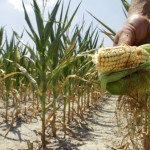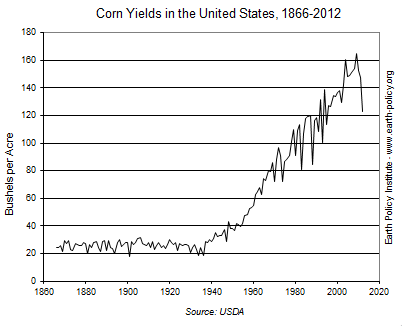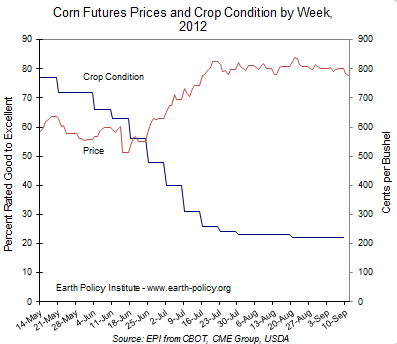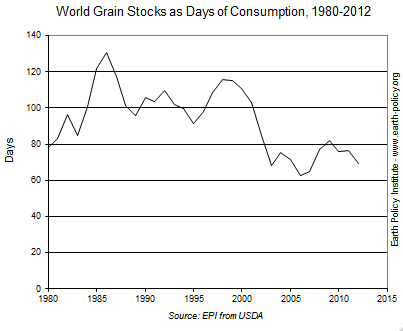
Global food stocks suffer after summer of heat and drought.
by Janet Larsen
September estimates from the US Department of Agriculture (USDA) show 2012 U.S. corn yields at 123 bushels per acre, down by a fourth from the 2009 high of 165 bushels per acre. Yields are the lowest since 1995 and well below the average of the last 30 years. The summer heat and drought also hit US soybean yields, which are down 20 percent from their 2009 peak.

High temperatures have combined with the worst drought in half a century to wreak havoc on American farms and ranches. Some 80 percent of US farm and pasture land experienced drought. The average temperature across the contiguous United States from January through August 2012 was far higher than in any past year, a full 4 degrees Fahrenheit above the twentieth century average, according to the National Climatic Data Center. The summer of 2012 was the third hottest on record. Only the summers of 2011 and 1936 — the latter during the Dust Bowl — were warmer.
In the top corn-producing state of Iowa, the spring was nearly 9 degrees Fahrenheit warmer than the average over the last century. This was followed by an unusually warm and dry summer. St Louis, Missouri, in the southern Corn Belt, suffered 11 days over 105 degrees Fahrenheit in the summer of 2012, more than ever before.
With soils desiccated by drought, the baking temperatures dried up corn silks and withered stalks.
With soils desiccated by drought, the baking temperatures dried up corn silks and withered stalks. As summer progressed, more of the country’s corn crop slipped from “good” or “excellent” condition, as rated each week by USDA, to “fair,” “poor,” or “very poor.” Corn prices ratcheted up. On July 19th, the price of a bushel of corn on the futures market climbed above $8 for the first time ever. By that point in the summer, only 26 percent of the US corn crop was in good shape, down from an estimated 77 percent early in the season.

This year has illustrated all too clearly the precarious relationship between temperature and yield. The “rule of thumb” is that each 1-degree-Celsius rise in temperature (1.8 degrees Fahrenheit) above the growing season optimum can cut productivity by 10 percent. Data from the field show that this may even be conservative. Once a high temperature threshold is crossed, plants cannot recover.
Carryover grain supplies in 2012 are projected to fall to 432 million tons, covering just 69 days of global consumption.

Carryover grain supplies in 2012 are projected to fall to 432 million tons, covering just 69 days of global consumption. With global warming making crop-damaging weather ever more likely, building a larger buffer of grain stocks — closer to 110 days of consumption — is more urgent than ever before.
For further reading on the global food situation, see Full Planet, Empty Plates: The New Geopolitics of Food Scarcity, by Lester R Brown (W.W. Norton: October 2012). A free preview chapter of this soon-to-be-released book is on-line at www.earth-policy.org/books/fpep.
Copyright © 2012 Earth Policy Institute
© Copyright 2012 Janet Larsen, All rights Reserved. Written For: StraightGoods.ca
One Response to “US Corn, soybean crops ravaged”
Sorry, the comment form is closed at this time.


The solution to climate change
The primary source of GHG is fossil fuel burning electrical generating facilities.http://dingo.care2.com/pictures/causes/uploads/2012/01/GHG-emitters-2010.jpg
7 Billion humans generate vast quantities of excrement. I believe this excrement is capable of providing all human electrical demands.http://en.wikipedia.org/wiki/Radiolysis
Right now hydrogen is perceived as a negative by product, of Nuclear Energy, when it should be the product, as the Pentagon has considered. reference info Request for Information (RFI) on Deployable Reactor Technologies … DARPA-SN-10-37@darpa.mil
https://www.fbo.gov/index?s=opportunity&mode=form&id=d0792af88a6a4484b3aa9d0dfeaaf553&…
Large scale conversions sites are intended to replace fossil fuel powered electrical facilities the Primary Source of Carbon Emissions.
http://www.populist.com/99.12.krebs.blob.html
In what officials now say was a mistaken strategy to reduce the waste's volume, organic chemicals were added years ago which were being bombarded by radiation fields, resulting in unwanted hydrogen. The hydrogen was then emitted in huge releases that official studies call burps, causing "waste-bergs," chunks of waste floating on the surface, to roll over.
Dennis Baker
106-998 Creston Avenue
Penticton BC V2A1P9
cell phone 250-462-3796
Phone / Fax 778-476-2633